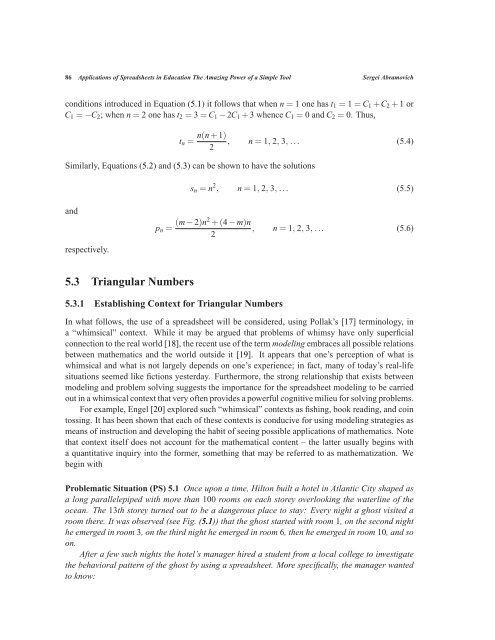chapter 3 - Bentham Science
chapter 3 - Bentham Science
chapter 3 - Bentham Science
Create successful ePaper yourself
Turn your PDF publications into a flip-book with our unique Google optimized e-Paper software.
86 Applications of Spreadsheets in Education The Amazing Power of a Simple Tool Sergei Abramovich<br />
conditions introduced in Equation (5.1) it follows that when n=1 one has t1 = 1= C1+C2+ 1 or<br />
C1 =−C2; when n=2 one has t2 = 3= C1− 2C1+ 3 whence C1 = 0 and C2 = 0. Thus,<br />
tn = n(n+1)<br />
, n=1, 2, 3,... (5.4)<br />
2<br />
Similarly, Equations (5.2) and (5.3) can be shown to have the solutions<br />
and<br />
respectively.<br />
5.3 Triangular Numbers<br />
sn = n 2 , n=1, 2, 3,... (5.5)<br />
pn = (m−2)n2 +(4−m)n<br />
, n=1, 2, 3,... (5.6)<br />
2<br />
5.3.1 Establishing Context for Triangular Numbers<br />
In what follows, the use of a spreadsheet will be considered, using Pollak’s [17] terminology, in<br />
a “whimsical” context. While it may be argued that problems of whimsy have only superficial<br />
connection to the real world [18], the recent use of the term modeling embraces all possible relations<br />
between mathematics and the world outside it [19]. It appears that one’s perception of what is<br />
whimsical and what is not largely depends on one’s experience; in fact, many of today’s real-life<br />
situations seemed like fictions yesterday. Furthermore, the strong relationship that exists between<br />
modeling and problem solving suggests the importance for the spreadsheet modeling to be carried<br />
out in a whimsical context that very often provides a powerful cognitive milieu for solving problems.<br />
For example, Engel [20] explored such “whimsical” contexts as fishing, book reading, and coin<br />
tossing. It has been shown that each of these contexts is conducive for using modeling strategies as<br />
means of instruction and developing the habit of seeing possible applications of mathematics. Note<br />
that context itself does not account for the mathematical content – the latter usually begins with<br />
a quantitative inquiry into the former, something that may be referred to as mathematization. We<br />
begin with<br />
Problematic Situation (PS) 5.1 Once upon a time, Hilton built a hotel in Atlantic City shaped as<br />
a long parallelepiped with more than 100 rooms on each storey overlooking the waterline of the<br />
ocean. The 13th storey turned out to be a dangerous place to stay: Every night a ghost visited a<br />
room there. It was observed (see Fig. (5.1)) that the ghost started with room 1, on the second night<br />
he emerged in room 3, on the third night he emerged in room 6, then he emerged in room 10, and so<br />
on.<br />
After a few such nights the hotel’s manager hired a student from a local college to investigate<br />
the behavioral pattern of the ghost by using a spreadsheet. More specifically, the manager wanted<br />
to know:

















